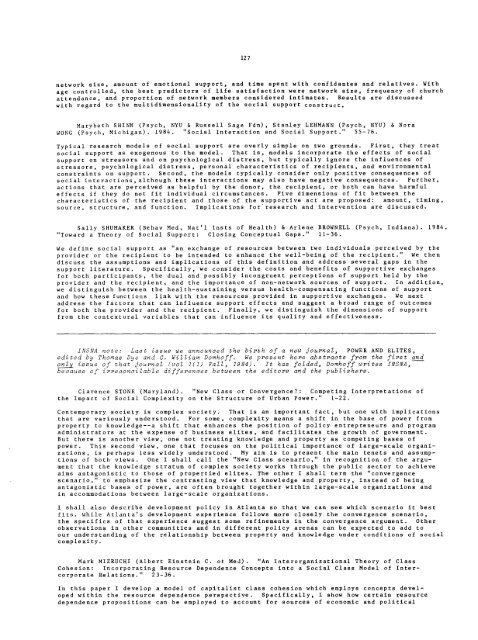(1985). Levine's Atlas of Corporate Interlocks. Connections ... - INSNA
(1985). Levine's Atlas of Corporate Interlocks. Connections ... - INSNA
(1985). Levine's Atlas of Corporate Interlocks. Connections ... - INSNA
You also want an ePaper? Increase the reach of your titles
YUMPU automatically turns print PDFs into web optimized ePapers that Google loves.
1 2 7<br />
network size, amount <strong>of</strong> emotional support, and time spent with confidantes and relatives . With<br />
age controlled, the best predictors <strong>of</strong> life satisfaction were network size, frequency <strong>of</strong> church<br />
attendance, and proportion <strong>of</strong> network members considered intimates . Results are discussed<br />
with regard to the multidimensionality <strong>of</strong> the social support construct .<br />
Marybeth SHINN (Psych, NYU & Russell Sage Fdn), Stanley LEHMANN (Psych, NYU) & Nora<br />
WONG (Psych, Michigan) . 1984 . "Social Interaction and Social Support ." 55-76 .<br />
Typical research models <strong>of</strong> social support are overly simple on two grounds . First, they treat<br />
social support as exogenous to the model . That is, models incorporate the effects <strong>of</strong> social<br />
support on stressors and on psychological distress, but typically ignore the influences <strong>of</strong><br />
stressors, psychological distress, personal characteristics <strong>of</strong> recipients, and environmental<br />
constraints on support . Second, the models typically consider only positive consequences <strong>of</strong><br />
social interactions, although these interactions may also have negative consequences . Further,<br />
actions that are perceived as helpful by the donor, the recipient, or both can have harmful<br />
effects if they do not fit individual circumstances . Five dimensions <strong>of</strong> fit between the<br />
characteristics <strong>of</strong> the recipient and those <strong>of</strong> the supportive act are proposed : amount, timing,<br />
source, structure, and function . Implications for'research and intervention are discussed .<br />
Sally SHUMAKER (Behav Med, Nat'l Insts <strong>of</strong> Health) & Arlene BROWNELL (Psych, Indiana) . 1984 .<br />
"Toward a Theory <strong>of</strong> Social Support : Closing Conceptual Gaps ." 11-36 .<br />
We define social support as "an exchange <strong>of</strong> resources between two individuals perceived by the<br />
provider or the recipient to be intended to enhance the well-being <strong>of</strong> the recipient ." We then<br />
discuss the assumptions and implications <strong>of</strong> this definition and address several gaps in the<br />
support literature . Specifically, we consider the costs and benefits <strong>of</strong> supportive exchanges<br />
for both participants, the dual and possibly incongruent perceptions <strong>of</strong> support held by the<br />
provider and the recipient, and the importance <strong>of</strong> non-network sources <strong>of</strong> support . In addition,<br />
we distinguish between the health-sustaining versus health-compensating functions <strong>of</strong> support<br />
and how these functions link with the resources provided in supportive exchanges . We next<br />
address the factors that can influence support effects and suggest a broad range <strong>of</strong> outcomes<br />
for both the provider and the recipient . Finally, we distinguish the dimensions <strong>of</strong> support<br />
from the contextural variables that can influence its quality and effectiveness .<br />
<strong>INSNA</strong> note : Last issue we announced the birth <strong>of</strong> a new journal, POWER AND ELITES,<br />
edited by Thomas Dye and G . William Domh<strong>of</strong>f. We present here abstracts from the first and<br />
only issue <strong>of</strong> that journal (vol 1(1) Fall, 1984) . It has folded, Domh<strong>of</strong>f writes <strong>INSNA</strong>,<br />
because <strong>of</strong> irreconcilable differences between the editors and the publishers .<br />
Clarence STONE (Maryland) . "New Class or Convergence : Competing Interpretations <strong>of</strong><br />
the Impact <strong>of</strong> Social Complexity on the Structure <strong>of</strong> Urban Power ." 1-22 .<br />
Contemporary society is complex society . That is an important fact, but one with implications<br />
that are variously understood . For some, complexity means a shift in the base <strong>of</strong> power from<br />
property to knowledge--a shift that enhances the position <strong>of</strong> policy entrepreneurs and program<br />
administrators at the expense <strong>of</strong> business elites, and facilitates the growth <strong>of</strong> government<br />
But there is another view, one not treating knowledge and property as competing bases <strong>of</strong><br />
power . This second view, one that focuses on the political importance <strong>of</strong> large-scale organizations,<br />
is perhaps less widely understood . My aim is to present the main tenets and assumptions<br />
<strong>of</strong> both views . One I shall call the "New Class scenario," in recognition <strong>of</strong> the argument<br />
that the knowledge stratum <strong>of</strong> complex society works through the public sector to achieve<br />
aims antagonistic to those <strong>of</strong> propertied elites . The other I shall term the "convergence<br />
scenario," to emphasize the contrasting view that knowledge and property, instead <strong>of</strong> being<br />
antagonistic bases <strong>of</strong> power, are <strong>of</strong>ten brought together within large-scale organizations and<br />
in accommodations between large-scale organizations .<br />
I shall also describe development policy in Atlanta so that we can see which scenario it best<br />
fits . While Atlanta's development experience follows more closely the convergence scenario,<br />
the specifics <strong>of</strong> that experience suggest some refinements in the convergence argument . Other<br />
observations in other communities and in different policy arenas can be expected to add to<br />
our understanding <strong>of</strong> the relationship between property and knowledge under conditions <strong>of</strong> social<br />
complexity .<br />
Mark MIZRUCHI (Albert Einstein C . <strong>of</strong> Med) . "An Interorganizational Theory <strong>of</strong> Class<br />
Cohesion : Incorporating Resource Dependence Concepts into a Social Class Model <strong>of</strong> Intercorporate<br />
Relations ." 23-36 .<br />
In this paper I develop a model <strong>of</strong> capitalist class cohesion which employs concepts developed<br />
within the resource dependence perspective . Specifically, I show how certain resource<br />
dependence propositions can be employed to account for sources <strong>of</strong> economic and political

















